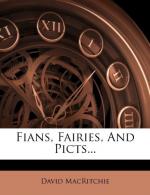From this we see that, about the twelfth century, the Cemetery of the Brugh contained at least fifty sepulchral mounds such as those described by Mr. Petrie at Cruachan. Mr. Petrie further quotes two passages from the Dinnsenchus, which specify in the following terms some of the most famous of those “monuments” at the Brugh:—
“The Grave [or Stone Cairn, Leacht] of the Dagda; the Grave of Aedh Luirgnech, son of the Dagda; the Graves of Cirr and Cuirrell, wives of the Dagda—’these are two hillocks [da cnoc]’; the Grave of Esclam, the Dagda’s Brehon, ’which is called Fert-Patric at this day’; the Cashel [or Stone Enclosure] of Angus, son of Crunmael; the Cave [Derc] of Buailcc Bec; the Stone Cairn [Leacht] of Cellach, son of Maelcobha; the Stone Cairn [Leacht] of the steed of Cinaedh, son of Irgalach; the Prison [Carcar] of Liath-Macha; the ‘Glen’ of the Mata; the Pillar Stone of Buidi, the son of Muiredh, where his head is interred; the Stone of Benn; the Grave of Boinn, the wife of Nechtan; the ‘Bed’ of the daughter of Forann; the Barc of Crimthann Nianar, in which he was interred; the Grave of Fedelmidh, the Lawgiver; the Cumot of Cairbre Lifeachair; the Fulacht of Fiachna Sraiphtine.”
These, of course, are only some of the most famous of the sepulchral monuments which existed in the Cemetery of the Brugh eight or nine centuries ago. Since that time, most of them have disappeared, their stones having been presumably built into castles, mansions, cottages and walls, while the bones of the queens and heroes have fertilised the soil of the neighbouring farms. But there still remain a few “standing-stones” and “moats” in the vicinity of the Brugh, all of which may be included in the above list.
I have cited that list for the reason that modern antiquaries, or many of them, have assumed that Sid in Broga and Relec in Broga are synonymous terms, and that when a king or hero is recorded to have been buried “at Brugh,” that means that he was buried in the Brugh itself. In other words, that a place which was known as Fert-Patrick in or about the twelfth century, as also the “cashel” and the many hillocks, graves, and cairns mentioned in the list—not to speak of innumerable others—were all situated in the chamber which is shown in Plate XIX. It does not require a moment’s reflection to convince one that this is an erroneous assumption. Nor is it warranted by the “History of the Cemeteries” itself, which always speaks of the burials having been “at Brugh."[86]




